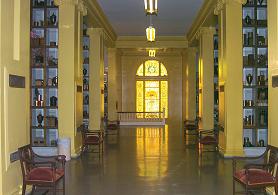The histories and mysteries of the Fresh Pond Crematory
What do famous Yankee baseball player Lou Gehrig, Bruno Hauptman, the person found guilty and then executed for the Lindbergh baby kidnapping, and the notable banker tycoon J.P. Morgan all have in common? All were cremated at the Fresh Pond Crematory. When many of us think about our final resting place we sometimes envision a somewhat storybook scene of a well-manicured plot of ground with a large granite headstone and, if we’re lucky, a shady tree or babbling brook nearby.
Not so for thousands of people who have chosen cremation as a way to bid this world farewell. Located at the top of a hill on Mount Olivet Crescent in Middle Village, Queens stands the Fresh Pond Crematory also known as the United States Columbarium Company. Surrounded by Belgium brick walkways, the building was erected in 1884 at a time when cremation in The United States was in its infancy. Only the Washington, Pennsylvania Crematory built in 1876 by Dr. Julius LeMoyne and the first public crematory in Lancaster, Pennsylvania, which opened in 1884, predates the building in Queens.
When Fresh Pond had its first cremation in 1885, the surrounding area was nothing more than farmland and dairies. The Brooklyn Bridge was recently opened to the public and it was a mere 20 years since the end of the Civil War.
A soft-spoken often-reflective man, Mr. J.P. DiTroia is the current President of the crematory. “We do exactly what nature does except we do it faster,” he said. DiTroia who has been working at the crematory for over 38 years starting when he was only 17, pointed out that the building is a crematory and a columbarium. He stated that many people forget that once cremated, the remains could then be memorialized and placed in the part of the building known as the columbarium. DiTroia explained that the word columbarium is derived from the Latin word column, which means dove. “Doves have nests, which are called niches, so a columbarium is a building of niches. A columbarium is more than just a place where we keep the ashes – it's an archive. We are the last bastions of record-keeping,” he said.
When first approaching the sizable structure, the one noticeable feature, which stands out amid the surrounding 6-foot iron fence and yellow brick walls is a high smokestack located near the center. It towers over the rest of the facility. It is here where the smoky byproduct of the cremation exists. The facility is comprised of two buildings, the taller standing 3 floors. Over the years many additions to the original structure have taken place starting with a new columbarium in 1893, the expansion of the columbarium above the crematory chambers in 1898 and other major expansions in 1904 and 1910.
After walking through the heavy bronze entrance doors, a marked silence fills the atmosphere, which possesses beautifully colored stained glass windows, oriental rugs and fine wooden furniture. The inside walls are made of thick Travertine marble while the floors consist of Terrazo and marble. In the inner sections of the building there are row upon row of niches, which give the appearance of time capsules that seem to invite visitors to view a space where time has stood still – compartments that have remained untouched from the very moment the deceased’s ashes were placed within. Moving around alone one can easily get lost as each room seems to blend with the next. The niches are separated by different themes such as the Room of Peace, Room of Memories and the Sanctuary Room.
If one looks beyond what at first appears to be a ghostly scene of old relics from a bygone era, a more meaningful experience emerges. In many ways the columbarium looks like a museum of past lives and gives an insight into our ultimate human condition‚ death. But it is also a place that attests love and affection from family and friends that will be displayed long after all the parties have passed away.Within each niche there are one or more urns, which retain the ashes of the deceased. The urns are uniquely personal as are the niches which hold them. Sometimes possessing hand written letters made by loved ones left behind or holding some favorite earthly possession of the deceased, the niche shows the communication link from one generation to the next and captivates those looking through its genealogical window. There are over 16,000 niches here each holding from one to nine remains, said DiTroia. New sections having names such as the Hall of Flowers, Hall of Serenity and Innocence, which is a new infant section, will increase the number of available niches as the columbarium continues to grow. The day-to-day inner workings of the crematory are as fascinating as the past lives of those whose remains are well kept within the solid walls. There are four operating chambers within the crematory located inside the Hall of Incineration. The chambers are the place where the deceased body is cremated but no cremation can occur without the assistance of a funeral director. Operating six days a week, the crematory currently processes anywhere from 1 to 5 cremations per day. According to DiTroia, the routine time
for cremation takes anywhere from two to three hours depending on the type of casket and the size the body. The body, which is comprised of more than 85% water and gases, is exposed to intense temperatures that reach upwards of 1,600 degrees. The heat transforms the body into shell-like particles and although the skull and rib cage are recognizable, the only other familiar items are the parts of the casket that have survived the furnace.
Afterwards the bone fragments are removed to another room for further processing. Any metal remaining is then removed via a magnetic process and the bone fragments mechanically pulverized into a fine ash. The ashes are then placed into a temporary container and sealed. Throughout the entire process the remains are given an identification number, which is ultimately stamped onto the temporary container.
Although the price of a basic cremation is $255, the cost of storage can range widely and usually depends upon the type of urn, and the niche location and size. As an example, a permanent storage arrangement with no visitation would cost approximately $385, whereas family arrangements could cost upwards of $16,000 to $17,000. The crematory can also accommodate services that are religious or non-religious in nature. A small chapel located on the grounds can provide the family a 10-minute service for a fee of $75. A service of half an hour would cost $175.
According to figures from the National Vital Statistics System, cremations in America are on the rise. In 1885 there were only 47 cremations in the United States compared to 650,776 in 2001. “There are at least 32,000 remains here at the columbarium,” said DiTroia who believes that opinions regarding cremation as a more mainstream form of memorializing are gaining popularity. Due in part to an acceptance by many religions, increase in population size and society keeping an eye on the rising cost of burials, crematories are seeing a marked increase in business and an interest in cremation more than ever before.
The Cremation Association of North America reports that in 2001 there were approximately 1,700 crematories in the
United States, 43 of which were located in New York. DiTroia is noticeably proud of the building‚ history and of the services it provides. “We want people to understand that we are always active and involved.” Eager to educate the community regarding cremation, he has one of the local Boy Scout troops participate in the annual United States flag retirement ceremony, which is the cremation of old or damaged flags. There is also a World Trade Center memorial at the facility. DiTroia believes that the message the crematory offers young people today is one of values.”I think it is very important for us to teach our youngsters to respect the dead. If you respect the dead, you'll respect the living.”




